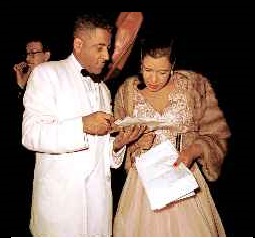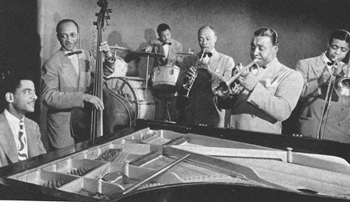
L-R:Lionel Hampton, Benny Goodman and Teddy Wilson. Photo by John W. Mosley, courtesy Temple University Libraries.
His theme song was “Jumpin’ on the Black and Whites.” And that’s how he spent his life—producing what many consider to be the most elegant piano jazz in swing. Teddy Wilson backed Louis Armstrong and Billie Holiday, then became a star playing with Benny Goodman and made history as one of the first black musicians to join a white band in public performances. Teddy Wilson’s understated, delicately-swinging piano style defined the Swing Era.
Wilson was born in 1912. As a young man trained in classical violin and piano, he got his first taste of jazz listening to recordings of Fats Waller, Duke Ellington and Earl Hines on a gramophone that belonged to a clerk in the campus drugstore at Tuskegee Institute where his father taught. Wilson had his first breaks in professional music in the early 1930s playing in Chicago with bands led by clarinetist Jimmie Noone and Louis Armstrong.
Then late one night in 1932 the self-styled talent scout, jazz promoter and record producer John Hammond heard Teddy Wilson ‘sitting in’ on a live broadcast from the Grand Terrace in Chicago. Hammond was so impressed that he fronted the cash to bring Wilson to New York to be a part of Benny Carter’s top-notch recording group, the Chocolate Dandies.

Teddy Wilson & Billie Holiday, Newport Jazz Festival on July 18, 1954. Photo courtesy of Michael Steinman.
Hammond was behind the scenes everywhere in the 1930s, spotting unknown singers and musicians, and pairing his favorites in concert dates and recording sessions. He soon adopted Teddy Wilson as one of his protégés. It was a winning combination when star maker Hammond teamed up Billie Holiday in a NY recording studio with Teddy Wilson in 1935. Wilson put together a group with the powerhouse trumpeter Roy Eldridge, a young ‘up and coming’ Benny Goodman on clarinet, and the great Ben Webster on tenor sax. The results were spectacular. They recorded four numbers on July 2, 1935, including the classics “Miss Brown to You” and “What a Little Moonlight Can Do.” It was the first of many outstanding Teddy Wilson and Billie Holiday recording sessions.
As a founding member of Benny Goodman’s enormously successful small ensembles, Wilson became a star of the Swing Era. His 1936 concert debut with the Benny Goodman Trio at the Congress Hotel in Chicago was a landmark in civil rights history. At the time, it made waves because it was the most visible instance of black and white musicians appearing together in public.

Teddy Wilson's sextet at Cafe Society, New York, 1942 L-R: Wilson, piano; Johnny Williams, dbl bass; Jack Parker, drums; Edmond Hall, clarinet; Emmett Berry, trumpet; and Benny Morton, trombone. Photo courtesy New Grove Dictionary of Jazz.
This week on Riverwalk Jazz, pianist Dick Hyman (who took piano lessons from Wilson as a student in New York), and vocalist Topsy Chapman join The Jim Cullum Jazz Band to celebrate The Magic Touch of Teddy Wilson.
Photo credit for Home Page: Pianist Teddy Wilson. Photo courtesy cloudtraveler.
Text based on Riverwalk Jazz script by Margaret Moos Pick ©2012


